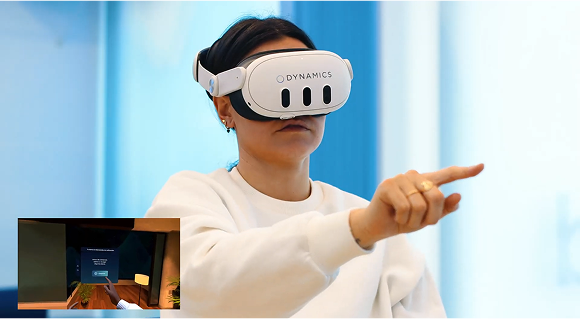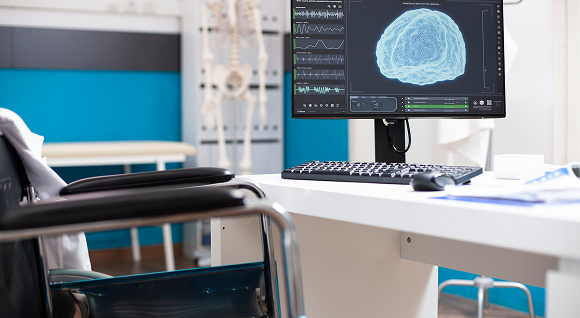How does Virtual Reality Rehabilitation work in Physical Therapy?
Explore how VR really works in physiotherapy: technology, sensors and immersive experience. Innovation for your clinic.
Dynamics VR – 07/24/2025
Table of Contents
- 1. What does rehabilitation with Virtual Reality consist of?
- 2. Devices and technology used
- What does the patient feel during a session?
- 4. Advantages over conventional therapies
- 5. How do we implement it in Dynamics VR?
- 6. Would you like to see how it works with your own patients?
Virtual Reality (VR) has revolutionized the field of physiotherapy. It is no longer just about repetitions on a stretcher: now your patients can move, play, discover and advance in their treatment within a virtual, safe and motivating environment. But how does this technology really work in rehabilitation?
What does rehabilitation with Virtual Reality consist of?
VR rehabilitation involves immersing the patient in a controlled, interactive, digital interactive environment that mimics real-world situations or creates specific scenarios for therapeutic training.
The patient interacts with this environment through his or her body, whose movements are reflected in a virtual avatar in real time. In this way, therapy is transformed into an engaging, sensorimotor rich experience with clear clinical objectives.
When patients see the avatar move as if it were their own body, it stimulates motor learning mechanisms that can modify altered body perception and facilitate new movement patterns. Environments that are meaningful to brain-damaged patients can enhance their motivation, thus improving the transfer of skills learned in session to their daily lives through motor learning.
When patients see the avatar move as if it were their own body, it stimulates motor learning mechanisms that can modify altered body perception and facilitate new movement patterns.
It is based on three fundamental pillars:
Presence: The patient feels that he/she is “inside” the virtual environment.
2. Immersion: The environment stimulates your senses and demands a physical and mental response from you (Kardong-Edgren et al., 2019).
3. Interactivity: The system reacts to your movements, which gives you control and active participation (Kamari et al., 2024).
These variables not only make the experience more engaging, but also activate key brain mechanisms for motor relearning and neuroplasticity.
Devices and technology used
There are several levels of virtual reality depending on the type of technology:
- Non-immersive VR: Accessed from a conventional monitor. The patient interacts with keyboard, mouse or other peripherals.
- Semi-immersive VR: Uses cameras or motion sensors (such as Kinect or Wii) where the patient sees him/herself reflected on the screen.
- Immersive VR: Uses Virtual Reality glasses (Head Mounted Display - HMD), allowing a complete and immersive simulation, both visual and auditory. This is the type we use at Dynamics VR, ideal for maximum therapeutic benefits.

What does the patient feel during a session?
When putting on the glasses, the patient enters another world, but with real goals: to move, to reach, to breathe, to stabilize, to discover. The feeling of control over their avatar, and the enriched environment, naturally awaken their attention and motivation.
Although virtual reality environments are very complex and extensive, in the case of specific rehabilitation software such as Dynamics, the patient will experience a guided session, where the movement of his avatar will be associated with his body, identifying new possibilities of body representation and mobility.
The distraction caused by Virtual Reality from painful movements allows the patient to perform movements in a wider range than they would without virtual reality, thus reducing the fear of movement and activating muscles and brain areas that have been affected by kinesiophobia.
Moreover, in programs such as Dynamics VR, the sessions are guided and clinically designed, so that each movement has a clear, measurable and adaptable therapeutic function for the patient.
Advantages over conventional therapies
These are some of the clinical and practical benefits most valued by physiotherapists and patients:
- Gamification = increased adherence: Accessed from a conventional monitor. The patient interacts with keyboard, mouse or other peripherals.
- Decreased fear of movement (kinesiophobia): Distracting yourself from pain, you dare to move more and better.
- Tracking automation: automatic counting of repetitions, joint range, speed, active time...
- Personalized treatments: The software adapts the level and type of exercise to each clinical case.
- Differential experience for the clinic: You position yourself as an innovative and cutting-edge center.
How do we implement it in Dynamics VR?
Our system includes everything you need to integrate VR seamlessly into your daily practice:
Virtual Reality Glasses
Control tablet for the therapist
Specialized clinical software (PainRehab and NeuroRehab)
Automatic recording of metrics
Personalized technical support and training
From the first session, you will notice the change: in the attitude of your patients, in the efficiency of your intervention and in the clinical results.

Would you like to see how it works with your own patients?
Request a demo of Dynamics VR and transform rehabilitation in your clinic.
You may be interested in...

By Dynamics VR l July 27, 2025.
Benefits of Virtual Reality Rehabilitation for your Patients
Learn about the benefits of VR rehabilitation: better adherence, less pain and better clinical results.
Why integrate Virtual Reality in your treatments?…

By Dynamics VR l July 24, 2025.
Neurological Rehabilitation with Virtual Reality: Innovation for Physical Therapy Clinics
Discover how virtual reality rehabilitation improves patient recovery. Advanced technology for modern clinics. Read more!
What is Virtual Reality Rehabilitation?…

